Enterprise Report: Strategic Management and Finance for M&S
VerifiedAdded on 2023/01/13
|13
|4072
|24
Report
AI Summary
This report examines the enterprise development of Marks and Spencer, focusing on strategic management principles, finance, and entrepreneurial leadership. It begins with an introduction to enterprise development, emphasizing its importance for organizational sustainability. The main body of the report delves into strategic enterprise management using SWOT analysis, evaluating finance and investment models like budget and forecasting, and analyzing their relationship to business models. It then explores entrepreneurial leadership, business planning (including the Ansoff Matrix), and entrepreneurial finance. Furthermore, the report demonstrates evaluative, research, and investigative skills in communicating entrepreneurial planning and decision-making using the Business Model Canvas. It also assesses how market dynamics impact business objectives using Porter's Five Forces. Finally, the report concludes by summarizing the key findings and demonstrating the relevance of each core topic within a business context. The report provides a comprehensive analysis of the business strategies and financial models employed by Marks and Spencer, emphasizing the importance of adapting to market trends and maintaining a competitive edge.
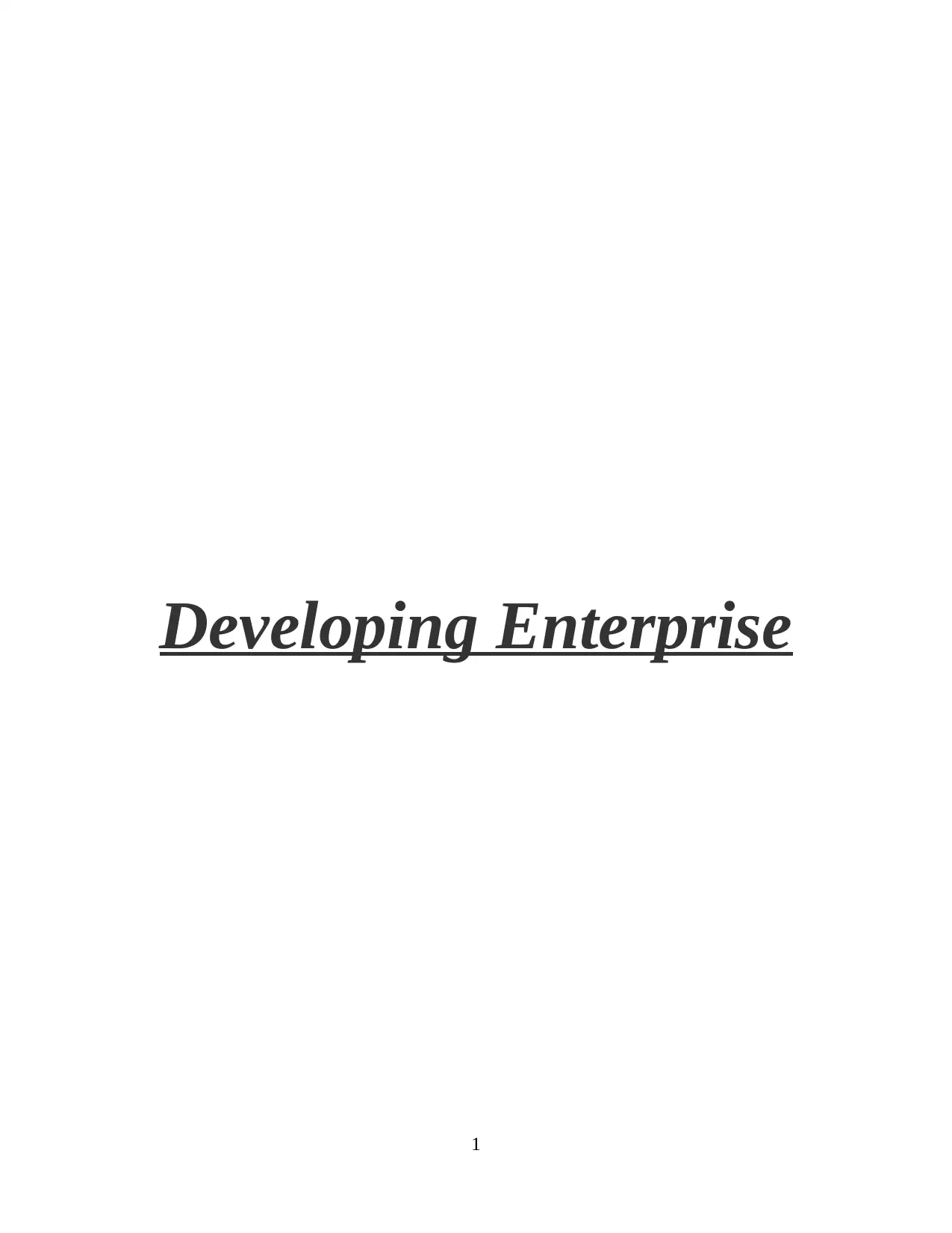
Developing Enterprise
1
1
Paraphrase This Document
Need a fresh take? Get an instant paraphrase of this document with our AI Paraphraser
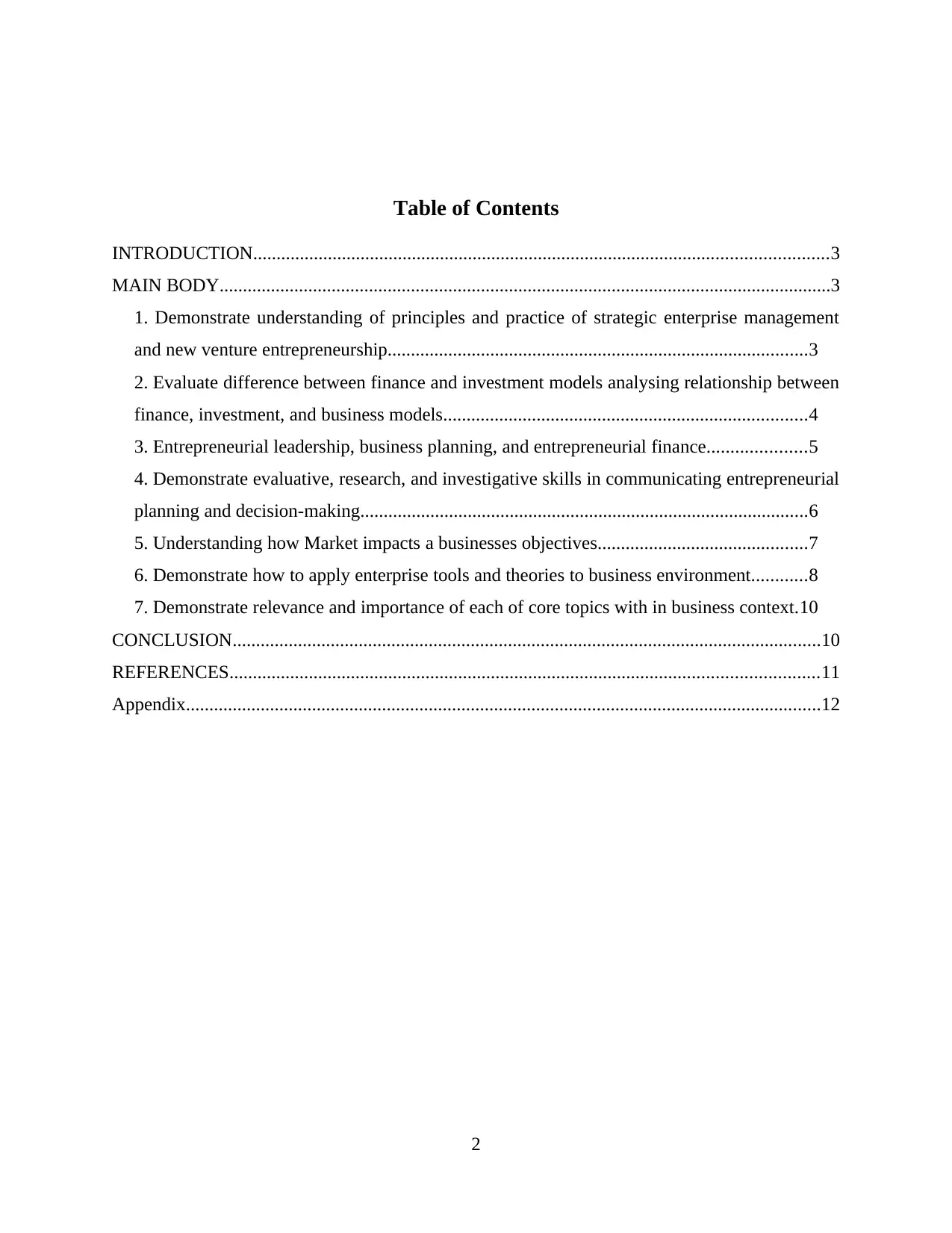
Table of Contents
INTRODUCTION...........................................................................................................................3
MAIN BODY...................................................................................................................................3
1. Demonstrate understanding of principles and practice of strategic enterprise management
and new venture entrepreneurship..........................................................................................3
2. Evaluate difference between finance and investment models analysing relationship between
finance, investment, and business models..............................................................................4
3. Entrepreneurial leadership, business planning, and entrepreneurial finance.....................5
4. Demonstrate evaluative, research, and investigative skills in communicating entrepreneurial
planning and decision-making................................................................................................6
5. Understanding how Market impacts a businesses objectives.............................................7
6. Demonstrate how to apply enterprise tools and theories to business environment............8
7. Demonstrate relevance and importance of each of core topics with in business context.10
CONCLUSION..............................................................................................................................10
REFERENCES..............................................................................................................................11
Appendix........................................................................................................................................12
2
INTRODUCTION...........................................................................................................................3
MAIN BODY...................................................................................................................................3
1. Demonstrate understanding of principles and practice of strategic enterprise management
and new venture entrepreneurship..........................................................................................3
2. Evaluate difference between finance and investment models analysing relationship between
finance, investment, and business models..............................................................................4
3. Entrepreneurial leadership, business planning, and entrepreneurial finance.....................5
4. Demonstrate evaluative, research, and investigative skills in communicating entrepreneurial
planning and decision-making................................................................................................6
5. Understanding how Market impacts a businesses objectives.............................................7
6. Demonstrate how to apply enterprise tools and theories to business environment............8
7. Demonstrate relevance and importance of each of core topics with in business context.10
CONCLUSION..............................................................................................................................10
REFERENCES..............................................................................................................................11
Appendix........................................................................................................................................12
2
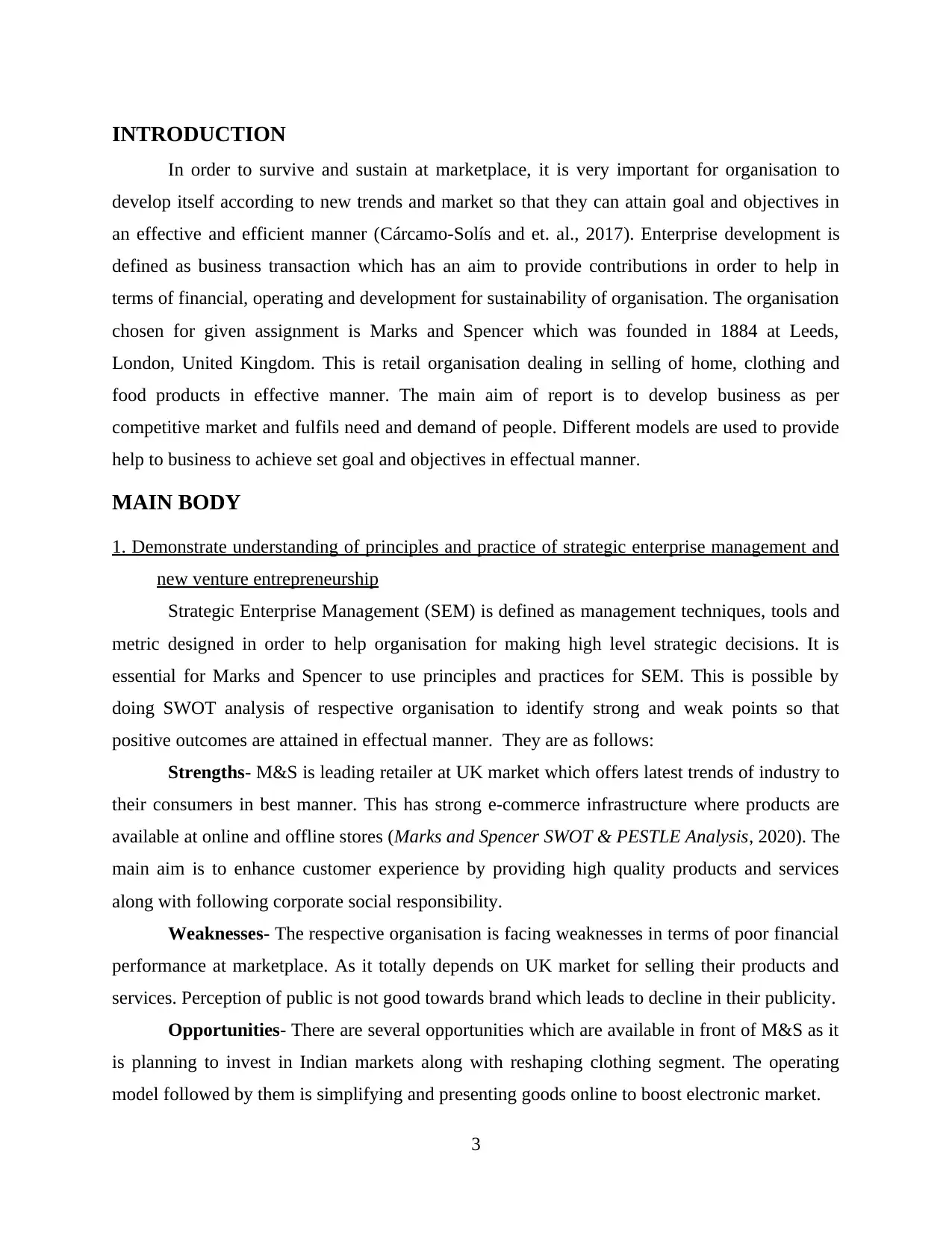
INTRODUCTION
In order to survive and sustain at marketplace, it is very important for organisation to
develop itself according to new trends and market so that they can attain goal and objectives in
an effective and efficient manner (Cárcamo-Solís and et. al., 2017). Enterprise development is
defined as business transaction which has an aim to provide contributions in order to help in
terms of financial, operating and development for sustainability of organisation. The organisation
chosen for given assignment is Marks and Spencer which was founded in 1884 at Leeds,
London, United Kingdom. This is retail organisation dealing in selling of home, clothing and
food products in effective manner. The main aim of report is to develop business as per
competitive market and fulfils need and demand of people. Different models are used to provide
help to business to achieve set goal and objectives in effectual manner.
MAIN BODY
1. Demonstrate understanding of principles and practice of strategic enterprise management and
new venture entrepreneurship
Strategic Enterprise Management (SEM) is defined as management techniques, tools and
metric designed in order to help organisation for making high level strategic decisions. It is
essential for Marks and Spencer to use principles and practices for SEM. This is possible by
doing SWOT analysis of respective organisation to identify strong and weak points so that
positive outcomes are attained in effectual manner. They are as follows:
Strengths- M&S is leading retailer at UK market which offers latest trends of industry to
their consumers in best manner. This has strong e-commerce infrastructure where products are
available at online and offline stores (Marks and Spencer SWOT & PESTLE Analysis, 2020). The
main aim is to enhance customer experience by providing high quality products and services
along with following corporate social responsibility.
Weaknesses- The respective organisation is facing weaknesses in terms of poor financial
performance at marketplace. As it totally depends on UK market for selling their products and
services. Perception of public is not good towards brand which leads to decline in their publicity.
Opportunities- There are several opportunities which are available in front of M&S as it
is planning to invest in Indian markets along with reshaping clothing segment. The operating
model followed by them is simplifying and presenting goods online to boost electronic market.
3
In order to survive and sustain at marketplace, it is very important for organisation to
develop itself according to new trends and market so that they can attain goal and objectives in
an effective and efficient manner (Cárcamo-Solís and et. al., 2017). Enterprise development is
defined as business transaction which has an aim to provide contributions in order to help in
terms of financial, operating and development for sustainability of organisation. The organisation
chosen for given assignment is Marks and Spencer which was founded in 1884 at Leeds,
London, United Kingdom. This is retail organisation dealing in selling of home, clothing and
food products in effective manner. The main aim of report is to develop business as per
competitive market and fulfils need and demand of people. Different models are used to provide
help to business to achieve set goal and objectives in effectual manner.
MAIN BODY
1. Demonstrate understanding of principles and practice of strategic enterprise management and
new venture entrepreneurship
Strategic Enterprise Management (SEM) is defined as management techniques, tools and
metric designed in order to help organisation for making high level strategic decisions. It is
essential for Marks and Spencer to use principles and practices for SEM. This is possible by
doing SWOT analysis of respective organisation to identify strong and weak points so that
positive outcomes are attained in effectual manner. They are as follows:
Strengths- M&S is leading retailer at UK market which offers latest trends of industry to
their consumers in best manner. This has strong e-commerce infrastructure where products are
available at online and offline stores (Marks and Spencer SWOT & PESTLE Analysis, 2020). The
main aim is to enhance customer experience by providing high quality products and services
along with following corporate social responsibility.
Weaknesses- The respective organisation is facing weaknesses in terms of poor financial
performance at marketplace. As it totally depends on UK market for selling their products and
services. Perception of public is not good towards brand which leads to decline in their publicity.
Opportunities- There are several opportunities which are available in front of M&S as it
is planning to invest in Indian markets along with reshaping clothing segment. The operating
model followed by them is simplifying and presenting goods online to boost electronic market.
3
⊘ This is a preview!⊘
Do you want full access?
Subscribe today to unlock all pages.

Trusted by 1+ million students worldwide
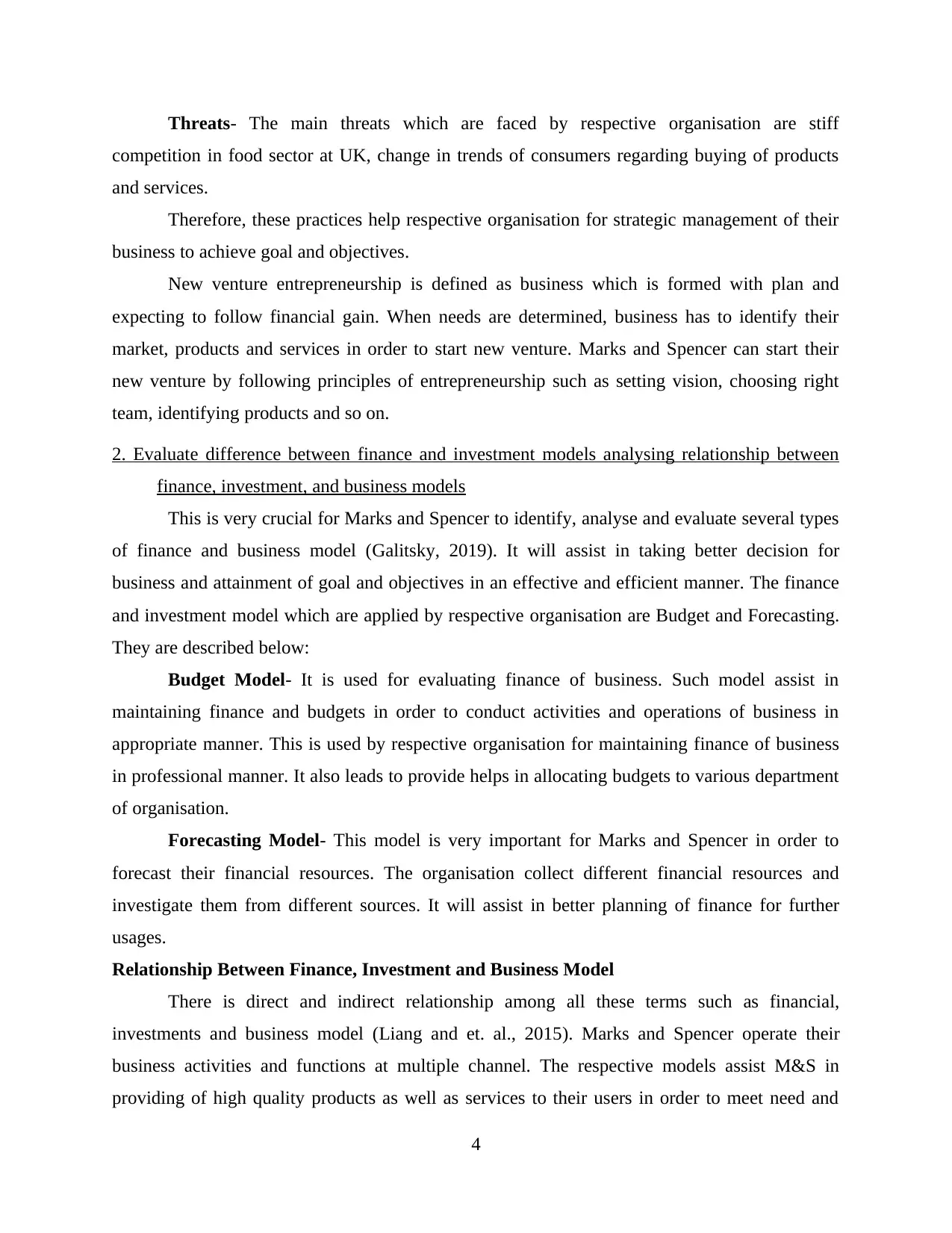
Threats- The main threats which are faced by respective organisation are stiff
competition in food sector at UK, change in trends of consumers regarding buying of products
and services.
Therefore, these practices help respective organisation for strategic management of their
business to achieve goal and objectives.
New venture entrepreneurship is defined as business which is formed with plan and
expecting to follow financial gain. When needs are determined, business has to identify their
market, products and services in order to start new venture. Marks and Spencer can start their
new venture by following principles of entrepreneurship such as setting vision, choosing right
team, identifying products and so on.
2. Evaluate difference between finance and investment models analysing relationship between
finance, investment, and business models
This is very crucial for Marks and Spencer to identify, analyse and evaluate several types
of finance and business model (Galitsky, 2019). It will assist in taking better decision for
business and attainment of goal and objectives in an effective and efficient manner. The finance
and investment model which are applied by respective organisation are Budget and Forecasting.
They are described below:
Budget Model- It is used for evaluating finance of business. Such model assist in
maintaining finance and budgets in order to conduct activities and operations of business in
appropriate manner. This is used by respective organisation for maintaining finance of business
in professional manner. It also leads to provide helps in allocating budgets to various department
of organisation.
Forecasting Model- This model is very important for Marks and Spencer in order to
forecast their financial resources. The organisation collect different financial resources and
investigate them from different sources. It will assist in better planning of finance for further
usages.
Relationship Between Finance, Investment and Business Model
There is direct and indirect relationship among all these terms such as financial,
investments and business model (Liang and et. al., 2015). Marks and Spencer operate their
business activities and functions at multiple channel. The respective models assist M&S in
providing of high quality products as well as services to their users in order to meet need and
4
competition in food sector at UK, change in trends of consumers regarding buying of products
and services.
Therefore, these practices help respective organisation for strategic management of their
business to achieve goal and objectives.
New venture entrepreneurship is defined as business which is formed with plan and
expecting to follow financial gain. When needs are determined, business has to identify their
market, products and services in order to start new venture. Marks and Spencer can start their
new venture by following principles of entrepreneurship such as setting vision, choosing right
team, identifying products and so on.
2. Evaluate difference between finance and investment models analysing relationship between
finance, investment, and business models
This is very crucial for Marks and Spencer to identify, analyse and evaluate several types
of finance and business model (Galitsky, 2019). It will assist in taking better decision for
business and attainment of goal and objectives in an effective and efficient manner. The finance
and investment model which are applied by respective organisation are Budget and Forecasting.
They are described below:
Budget Model- It is used for evaluating finance of business. Such model assist in
maintaining finance and budgets in order to conduct activities and operations of business in
appropriate manner. This is used by respective organisation for maintaining finance of business
in professional manner. It also leads to provide helps in allocating budgets to various department
of organisation.
Forecasting Model- This model is very important for Marks and Spencer in order to
forecast their financial resources. The organisation collect different financial resources and
investigate them from different sources. It will assist in better planning of finance for further
usages.
Relationship Between Finance, Investment and Business Model
There is direct and indirect relationship among all these terms such as financial,
investments and business model (Liang and et. al., 2015). Marks and Spencer operate their
business activities and functions at multiple channel. The respective models assist M&S in
providing of high quality products as well as services to their users in order to meet need and
4
Paraphrase This Document
Need a fresh take? Get an instant paraphrase of this document with our AI Paraphraser
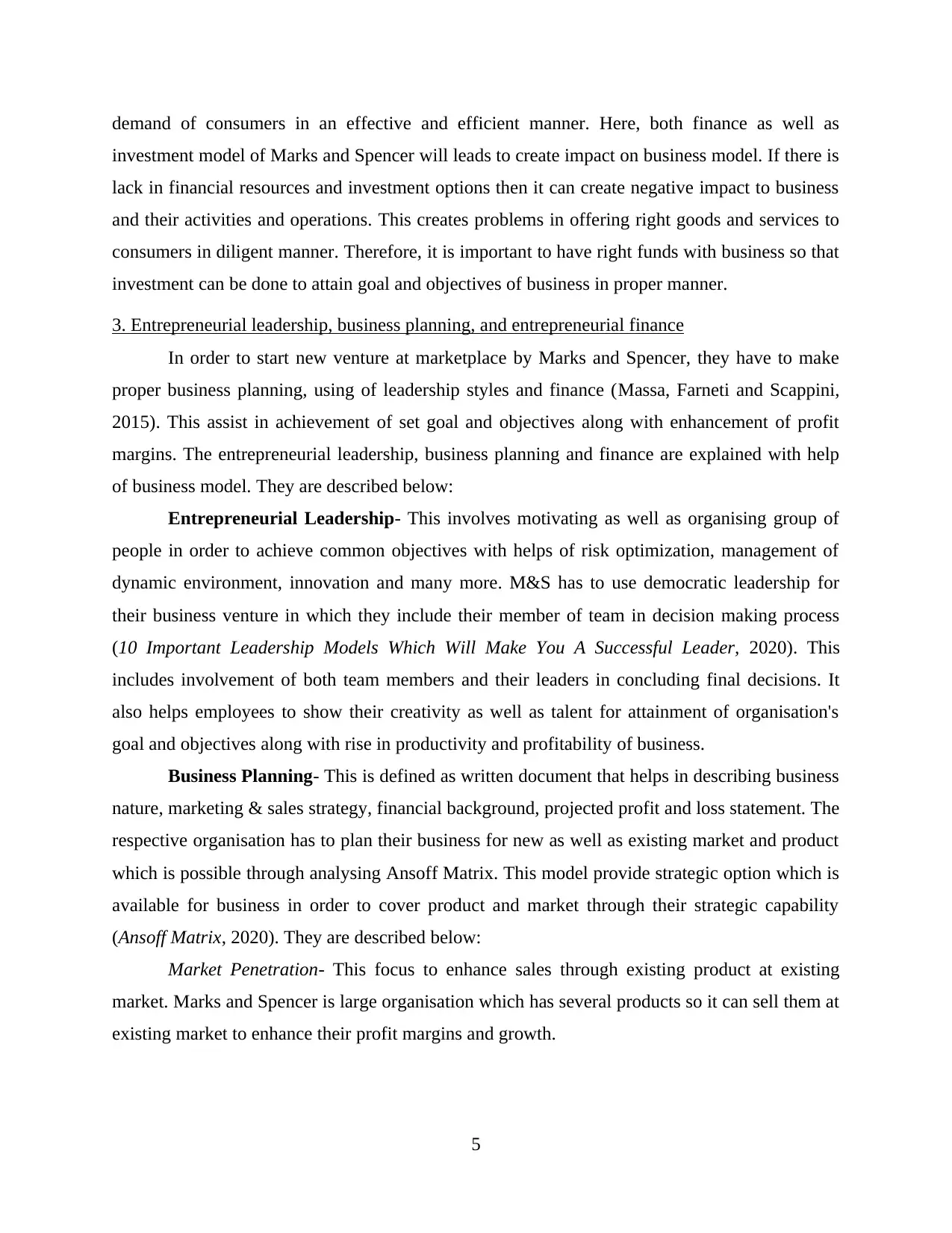
demand of consumers in an effective and efficient manner. Here, both finance as well as
investment model of Marks and Spencer will leads to create impact on business model. If there is
lack in financial resources and investment options then it can create negative impact to business
and their activities and operations. This creates problems in offering right goods and services to
consumers in diligent manner. Therefore, it is important to have right funds with business so that
investment can be done to attain goal and objectives of business in proper manner.
3. Entrepreneurial leadership, business planning, and entrepreneurial finance
In order to start new venture at marketplace by Marks and Spencer, they have to make
proper business planning, using of leadership styles and finance (Massa, Farneti and Scappini,
2015). This assist in achievement of set goal and objectives along with enhancement of profit
margins. The entrepreneurial leadership, business planning and finance are explained with help
of business model. They are described below:
Entrepreneurial Leadership- This involves motivating as well as organising group of
people in order to achieve common objectives with helps of risk optimization, management of
dynamic environment, innovation and many more. M&S has to use democratic leadership for
their business venture in which they include their member of team in decision making process
(10 Important Leadership Models Which Will Make You A Successful Leader, 2020). This
includes involvement of both team members and their leaders in concluding final decisions. It
also helps employees to show their creativity as well as talent for attainment of organisation's
goal and objectives along with rise in productivity and profitability of business.
Business Planning- This is defined as written document that helps in describing business
nature, marketing & sales strategy, financial background, projected profit and loss statement. The
respective organisation has to plan their business for new as well as existing market and product
which is possible through analysing Ansoff Matrix. This model provide strategic option which is
available for business in order to cover product and market through their strategic capability
(Ansoff Matrix, 2020). They are described below:
Market Penetration- This focus to enhance sales through existing product at existing
market. Marks and Spencer is large organisation which has several products so it can sell them at
existing market to enhance their profit margins and growth.
5
investment model of Marks and Spencer will leads to create impact on business model. If there is
lack in financial resources and investment options then it can create negative impact to business
and their activities and operations. This creates problems in offering right goods and services to
consumers in diligent manner. Therefore, it is important to have right funds with business so that
investment can be done to attain goal and objectives of business in proper manner.
3. Entrepreneurial leadership, business planning, and entrepreneurial finance
In order to start new venture at marketplace by Marks and Spencer, they have to make
proper business planning, using of leadership styles and finance (Massa, Farneti and Scappini,
2015). This assist in achievement of set goal and objectives along with enhancement of profit
margins. The entrepreneurial leadership, business planning and finance are explained with help
of business model. They are described below:
Entrepreneurial Leadership- This involves motivating as well as organising group of
people in order to achieve common objectives with helps of risk optimization, management of
dynamic environment, innovation and many more. M&S has to use democratic leadership for
their business venture in which they include their member of team in decision making process
(10 Important Leadership Models Which Will Make You A Successful Leader, 2020). This
includes involvement of both team members and their leaders in concluding final decisions. It
also helps employees to show their creativity as well as talent for attainment of organisation's
goal and objectives along with rise in productivity and profitability of business.
Business Planning- This is defined as written document that helps in describing business
nature, marketing & sales strategy, financial background, projected profit and loss statement. The
respective organisation has to plan their business for new as well as existing market and product
which is possible through analysing Ansoff Matrix. This model provide strategic option which is
available for business in order to cover product and market through their strategic capability
(Ansoff Matrix, 2020). They are described below:
Market Penetration- This focus to enhance sales through existing product at existing
market. Marks and Spencer is large organisation which has several products so it can sell them at
existing market to enhance their profit margins and growth.
5
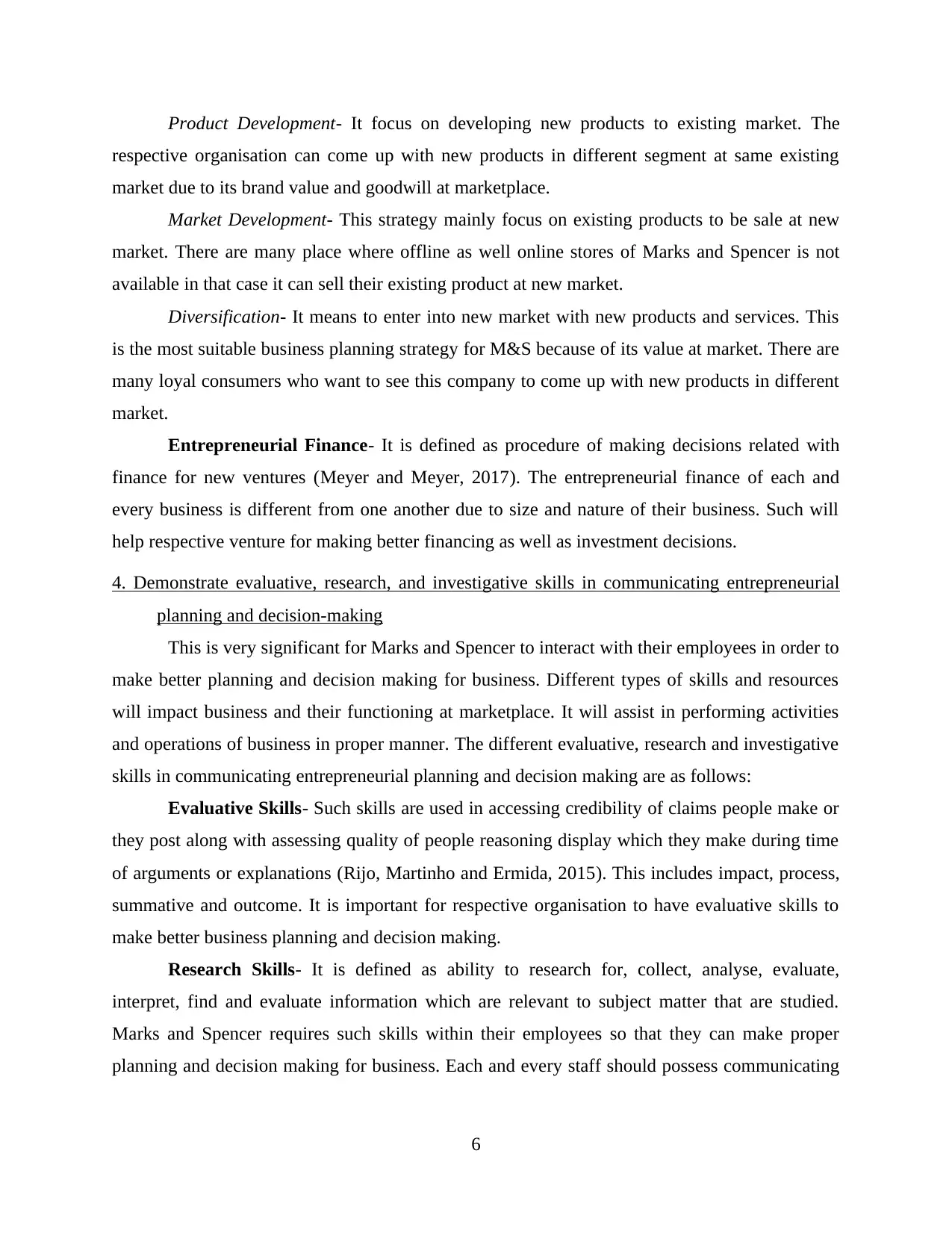
Product Development- It focus on developing new products to existing market. The
respective organisation can come up with new products in different segment at same existing
market due to its brand value and goodwill at marketplace.
Market Development- This strategy mainly focus on existing products to be sale at new
market. There are many place where offline as well online stores of Marks and Spencer is not
available in that case it can sell their existing product at new market.
Diversification- It means to enter into new market with new products and services. This
is the most suitable business planning strategy for M&S because of its value at market. There are
many loyal consumers who want to see this company to come up with new products in different
market.
Entrepreneurial Finance- It is defined as procedure of making decisions related with
finance for new ventures (Meyer and Meyer, 2017). The entrepreneurial finance of each and
every business is different from one another due to size and nature of their business. Such will
help respective venture for making better financing as well as investment decisions.
4. Demonstrate evaluative, research, and investigative skills in communicating entrepreneurial
planning and decision-making
This is very significant for Marks and Spencer to interact with their employees in order to
make better planning and decision making for business. Different types of skills and resources
will impact business and their functioning at marketplace. It will assist in performing activities
and operations of business in proper manner. The different evaluative, research and investigative
skills in communicating entrepreneurial planning and decision making are as follows:
Evaluative Skills- Such skills are used in accessing credibility of claims people make or
they post along with assessing quality of people reasoning display which they make during time
of arguments or explanations (Rijo, Martinho and Ermida, 2015). This includes impact, process,
summative and outcome. It is important for respective organisation to have evaluative skills to
make better business planning and decision making.
Research Skills- It is defined as ability to research for, collect, analyse, evaluate,
interpret, find and evaluate information which are relevant to subject matter that are studied.
Marks and Spencer requires such skills within their employees so that they can make proper
planning and decision making for business. Each and every staff should possess communicating
6
respective organisation can come up with new products in different segment at same existing
market due to its brand value and goodwill at marketplace.
Market Development- This strategy mainly focus on existing products to be sale at new
market. There are many place where offline as well online stores of Marks and Spencer is not
available in that case it can sell their existing product at new market.
Diversification- It means to enter into new market with new products and services. This
is the most suitable business planning strategy for M&S because of its value at market. There are
many loyal consumers who want to see this company to come up with new products in different
market.
Entrepreneurial Finance- It is defined as procedure of making decisions related with
finance for new ventures (Meyer and Meyer, 2017). The entrepreneurial finance of each and
every business is different from one another due to size and nature of their business. Such will
help respective venture for making better financing as well as investment decisions.
4. Demonstrate evaluative, research, and investigative skills in communicating entrepreneurial
planning and decision-making
This is very significant for Marks and Spencer to interact with their employees in order to
make better planning and decision making for business. Different types of skills and resources
will impact business and their functioning at marketplace. It will assist in performing activities
and operations of business in proper manner. The different evaluative, research and investigative
skills in communicating entrepreneurial planning and decision making are as follows:
Evaluative Skills- Such skills are used in accessing credibility of claims people make or
they post along with assessing quality of people reasoning display which they make during time
of arguments or explanations (Rijo, Martinho and Ermida, 2015). This includes impact, process,
summative and outcome. It is important for respective organisation to have evaluative skills to
make better business planning and decision making.
Research Skills- It is defined as ability to research for, collect, analyse, evaluate,
interpret, find and evaluate information which are relevant to subject matter that are studied.
Marks and Spencer requires such skills within their employees so that they can make proper
planning and decision making for business. Each and every staff should possess communicating
6
⊘ This is a preview!⊘
Do you want full access?
Subscribe today to unlock all pages.

Trusted by 1+ million students worldwide
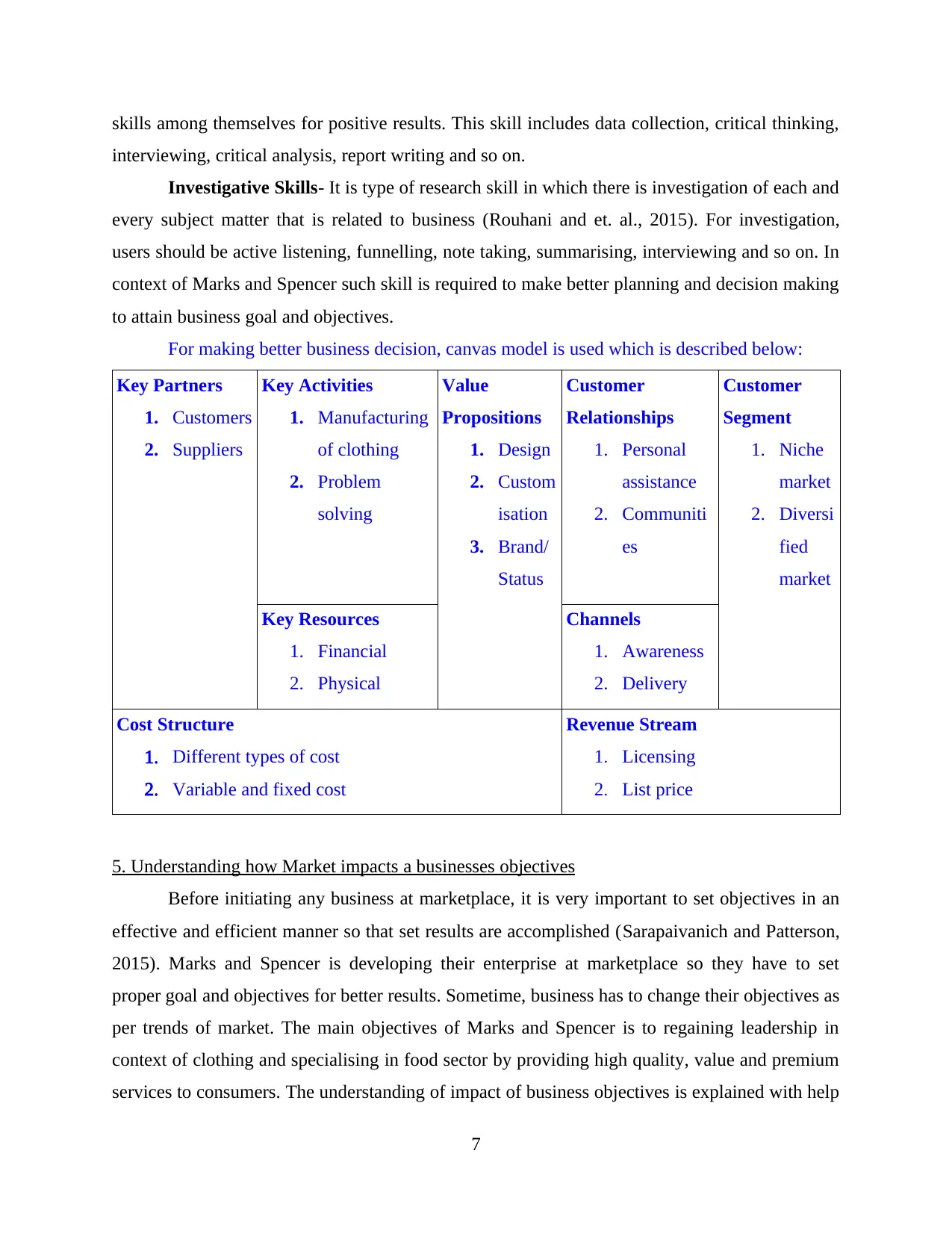
skills among themselves for positive results. This skill includes data collection, critical thinking,
interviewing, critical analysis, report writing and so on.
Investigative Skills- It is type of research skill in which there is investigation of each and
every subject matter that is related to business (Rouhani and et. al., 2015). For investigation,
users should be active listening, funnelling, note taking, summarising, interviewing and so on. In
context of Marks and Spencer such skill is required to make better planning and decision making
to attain business goal and objectives.
For making better business decision, canvas model is used which is described below:
Key Partners
1. Customers
2. Suppliers
Key Activities
1. Manufacturing
of clothing
2. Problem
solving
Value
Propositions
1. Design
2. Custom
isation
3. Brand/
Status
Customer
Relationships
1. Personal
assistance
2. Communiti
es
Customer
Segment
1. Niche
market
2. Diversi
fied
market
Key Resources
1. Financial
2. Physical
Channels
1. Awareness
2. Delivery
Cost Structure
1. Different types of cost
2. Variable and fixed cost
Revenue Stream
1. Licensing
2. List price
5. Understanding how Market impacts a businesses objectives
Before initiating any business at marketplace, it is very important to set objectives in an
effective and efficient manner so that set results are accomplished (Sarapaivanich and Patterson,
2015). Marks and Spencer is developing their enterprise at marketplace so they have to set
proper goal and objectives for better results. Sometime, business has to change their objectives as
per trends of market. The main objectives of Marks and Spencer is to regaining leadership in
context of clothing and specialising in food sector by providing high quality, value and premium
services to consumers. The understanding of impact of business objectives is explained with help
7
interviewing, critical analysis, report writing and so on.
Investigative Skills- It is type of research skill in which there is investigation of each and
every subject matter that is related to business (Rouhani and et. al., 2015). For investigation,
users should be active listening, funnelling, note taking, summarising, interviewing and so on. In
context of Marks and Spencer such skill is required to make better planning and decision making
to attain business goal and objectives.
For making better business decision, canvas model is used which is described below:
Key Partners
1. Customers
2. Suppliers
Key Activities
1. Manufacturing
of clothing
2. Problem
solving
Value
Propositions
1. Design
2. Custom
isation
3. Brand/
Status
Customer
Relationships
1. Personal
assistance
2. Communiti
es
Customer
Segment
1. Niche
market
2. Diversi
fied
market
Key Resources
1. Financial
2. Physical
Channels
1. Awareness
2. Delivery
Cost Structure
1. Different types of cost
2. Variable and fixed cost
Revenue Stream
1. Licensing
2. List price
5. Understanding how Market impacts a businesses objectives
Before initiating any business at marketplace, it is very important to set objectives in an
effective and efficient manner so that set results are accomplished (Sarapaivanich and Patterson,
2015). Marks and Spencer is developing their enterprise at marketplace so they have to set
proper goal and objectives for better results. Sometime, business has to change their objectives as
per trends of market. The main objectives of Marks and Spencer is to regaining leadership in
context of clothing and specialising in food sector by providing high quality, value and premium
services to consumers. The understanding of impact of business objectives is explained with help
7
Paraphrase This Document
Need a fresh take? Get an instant paraphrase of this document with our AI Paraphraser
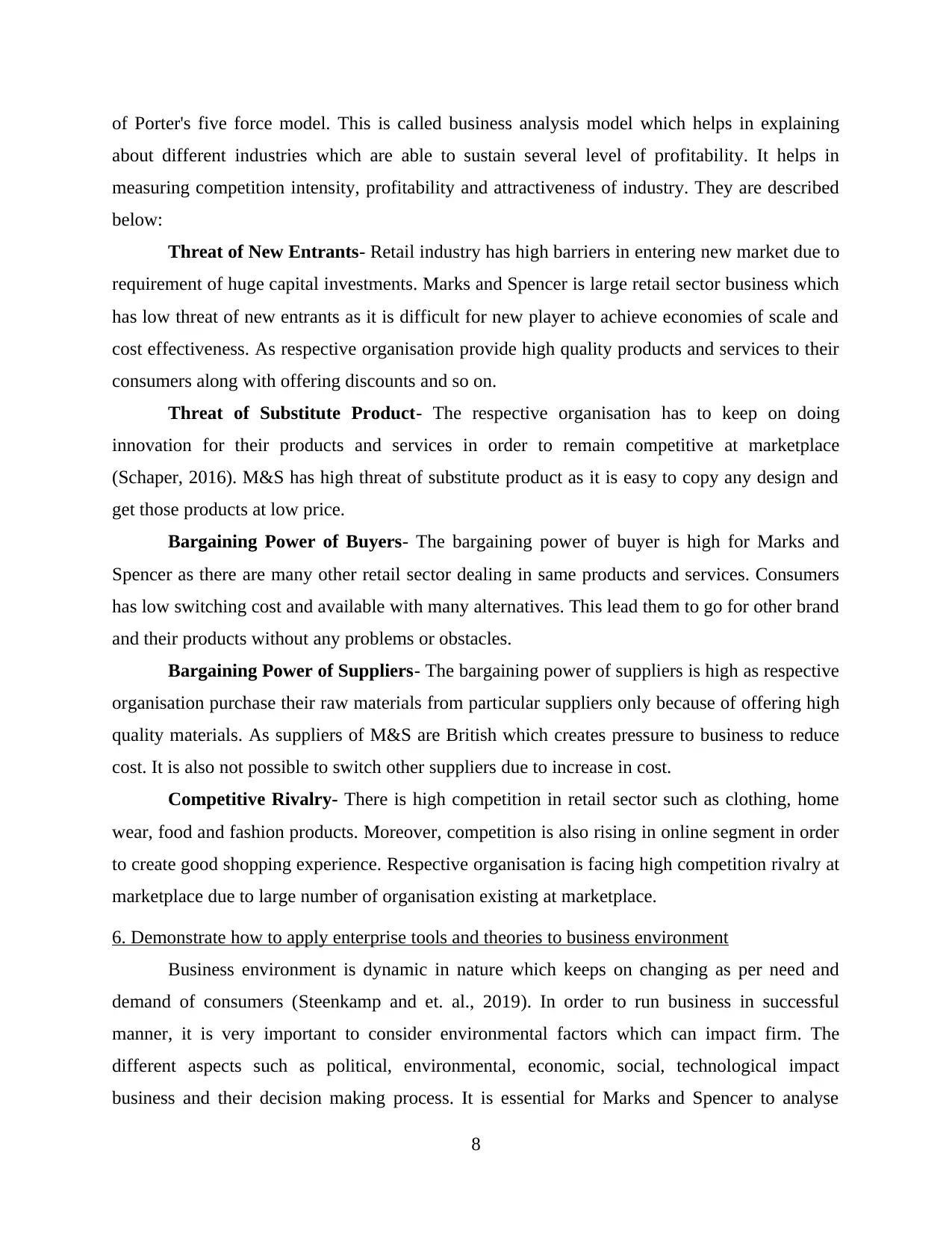
of Porter's five force model. This is called business analysis model which helps in explaining
about different industries which are able to sustain several level of profitability. It helps in
measuring competition intensity, profitability and attractiveness of industry. They are described
below:
Threat of New Entrants- Retail industry has high barriers in entering new market due to
requirement of huge capital investments. Marks and Spencer is large retail sector business which
has low threat of new entrants as it is difficult for new player to achieve economies of scale and
cost effectiveness. As respective organisation provide high quality products and services to their
consumers along with offering discounts and so on.
Threat of Substitute Product- The respective organisation has to keep on doing
innovation for their products and services in order to remain competitive at marketplace
(Schaper, 2016). M&S has high threat of substitute product as it is easy to copy any design and
get those products at low price.
Bargaining Power of Buyers- The bargaining power of buyer is high for Marks and
Spencer as there are many other retail sector dealing in same products and services. Consumers
has low switching cost and available with many alternatives. This lead them to go for other brand
and their products without any problems or obstacles.
Bargaining Power of Suppliers- The bargaining power of suppliers is high as respective
organisation purchase their raw materials from particular suppliers only because of offering high
quality materials. As suppliers of M&S are British which creates pressure to business to reduce
cost. It is also not possible to switch other suppliers due to increase in cost.
Competitive Rivalry- There is high competition in retail sector such as clothing, home
wear, food and fashion products. Moreover, competition is also rising in online segment in order
to create good shopping experience. Respective organisation is facing high competition rivalry at
marketplace due to large number of organisation existing at marketplace.
6. Demonstrate how to apply enterprise tools and theories to business environment
Business environment is dynamic in nature which keeps on changing as per need and
demand of consumers (Steenkamp and et. al., 2019). In order to run business in successful
manner, it is very important to consider environmental factors which can impact firm. The
different aspects such as political, environmental, economic, social, technological impact
business and their decision making process. It is essential for Marks and Spencer to analyse
8
about different industries which are able to sustain several level of profitability. It helps in
measuring competition intensity, profitability and attractiveness of industry. They are described
below:
Threat of New Entrants- Retail industry has high barriers in entering new market due to
requirement of huge capital investments. Marks and Spencer is large retail sector business which
has low threat of new entrants as it is difficult for new player to achieve economies of scale and
cost effectiveness. As respective organisation provide high quality products and services to their
consumers along with offering discounts and so on.
Threat of Substitute Product- The respective organisation has to keep on doing
innovation for their products and services in order to remain competitive at marketplace
(Schaper, 2016). M&S has high threat of substitute product as it is easy to copy any design and
get those products at low price.
Bargaining Power of Buyers- The bargaining power of buyer is high for Marks and
Spencer as there are many other retail sector dealing in same products and services. Consumers
has low switching cost and available with many alternatives. This lead them to go for other brand
and their products without any problems or obstacles.
Bargaining Power of Suppliers- The bargaining power of suppliers is high as respective
organisation purchase their raw materials from particular suppliers only because of offering high
quality materials. As suppliers of M&S are British which creates pressure to business to reduce
cost. It is also not possible to switch other suppliers due to increase in cost.
Competitive Rivalry- There is high competition in retail sector such as clothing, home
wear, food and fashion products. Moreover, competition is also rising in online segment in order
to create good shopping experience. Respective organisation is facing high competition rivalry at
marketplace due to large number of organisation existing at marketplace.
6. Demonstrate how to apply enterprise tools and theories to business environment
Business environment is dynamic in nature which keeps on changing as per need and
demand of consumers (Steenkamp and et. al., 2019). In order to run business in successful
manner, it is very important to consider environmental factors which can impact firm. The
different aspects such as political, environmental, economic, social, technological impact
business and their decision making process. It is essential for Marks and Spencer to analyse
8
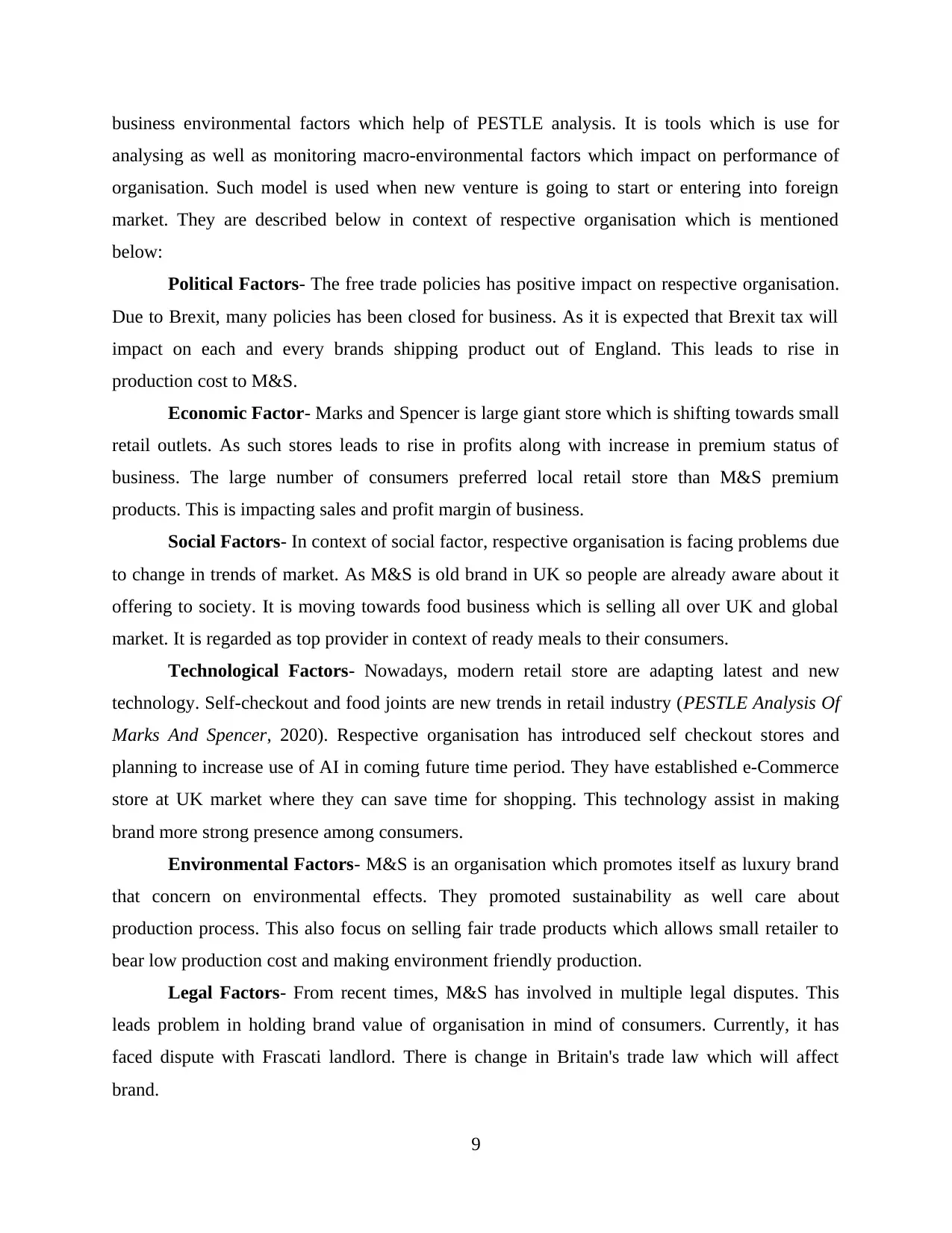
business environmental factors which help of PESTLE analysis. It is tools which is use for
analysing as well as monitoring macro-environmental factors which impact on performance of
organisation. Such model is used when new venture is going to start or entering into foreign
market. They are described below in context of respective organisation which is mentioned
below:
Political Factors- The free trade policies has positive impact on respective organisation.
Due to Brexit, many policies has been closed for business. As it is expected that Brexit tax will
impact on each and every brands shipping product out of England. This leads to rise in
production cost to M&S.
Economic Factor- Marks and Spencer is large giant store which is shifting towards small
retail outlets. As such stores leads to rise in profits along with increase in premium status of
business. The large number of consumers preferred local retail store than M&S premium
products. This is impacting sales and profit margin of business.
Social Factors- In context of social factor, respective organisation is facing problems due
to change in trends of market. As M&S is old brand in UK so people are already aware about it
offering to society. It is moving towards food business which is selling all over UK and global
market. It is regarded as top provider in context of ready meals to their consumers.
Technological Factors- Nowadays, modern retail store are adapting latest and new
technology. Self-checkout and food joints are new trends in retail industry (PESTLE Analysis Of
Marks And Spencer, 2020). Respective organisation has introduced self checkout stores and
planning to increase use of AI in coming future time period. They have established e-Commerce
store at UK market where they can save time for shopping. This technology assist in making
brand more strong presence among consumers.
Environmental Factors- M&S is an organisation which promotes itself as luxury brand
that concern on environmental effects. They promoted sustainability as well care about
production process. This also focus on selling fair trade products which allows small retailer to
bear low production cost and making environment friendly production.
Legal Factors- From recent times, M&S has involved in multiple legal disputes. This
leads problem in holding brand value of organisation in mind of consumers. Currently, it has
faced dispute with Frascati landlord. There is change in Britain's trade law which will affect
brand.
9
analysing as well as monitoring macro-environmental factors which impact on performance of
organisation. Such model is used when new venture is going to start or entering into foreign
market. They are described below in context of respective organisation which is mentioned
below:
Political Factors- The free trade policies has positive impact on respective organisation.
Due to Brexit, many policies has been closed for business. As it is expected that Brexit tax will
impact on each and every brands shipping product out of England. This leads to rise in
production cost to M&S.
Economic Factor- Marks and Spencer is large giant store which is shifting towards small
retail outlets. As such stores leads to rise in profits along with increase in premium status of
business. The large number of consumers preferred local retail store than M&S premium
products. This is impacting sales and profit margin of business.
Social Factors- In context of social factor, respective organisation is facing problems due
to change in trends of market. As M&S is old brand in UK so people are already aware about it
offering to society. It is moving towards food business which is selling all over UK and global
market. It is regarded as top provider in context of ready meals to their consumers.
Technological Factors- Nowadays, modern retail store are adapting latest and new
technology. Self-checkout and food joints are new trends in retail industry (PESTLE Analysis Of
Marks And Spencer, 2020). Respective organisation has introduced self checkout stores and
planning to increase use of AI in coming future time period. They have established e-Commerce
store at UK market where they can save time for shopping. This technology assist in making
brand more strong presence among consumers.
Environmental Factors- M&S is an organisation which promotes itself as luxury brand
that concern on environmental effects. They promoted sustainability as well care about
production process. This also focus on selling fair trade products which allows small retailer to
bear low production cost and making environment friendly production.
Legal Factors- From recent times, M&S has involved in multiple legal disputes. This
leads problem in holding brand value of organisation in mind of consumers. Currently, it has
faced dispute with Frascati landlord. There is change in Britain's trade law which will affect
brand.
9
⊘ This is a preview!⊘
Do you want full access?
Subscribe today to unlock all pages.

Trusted by 1+ million students worldwide
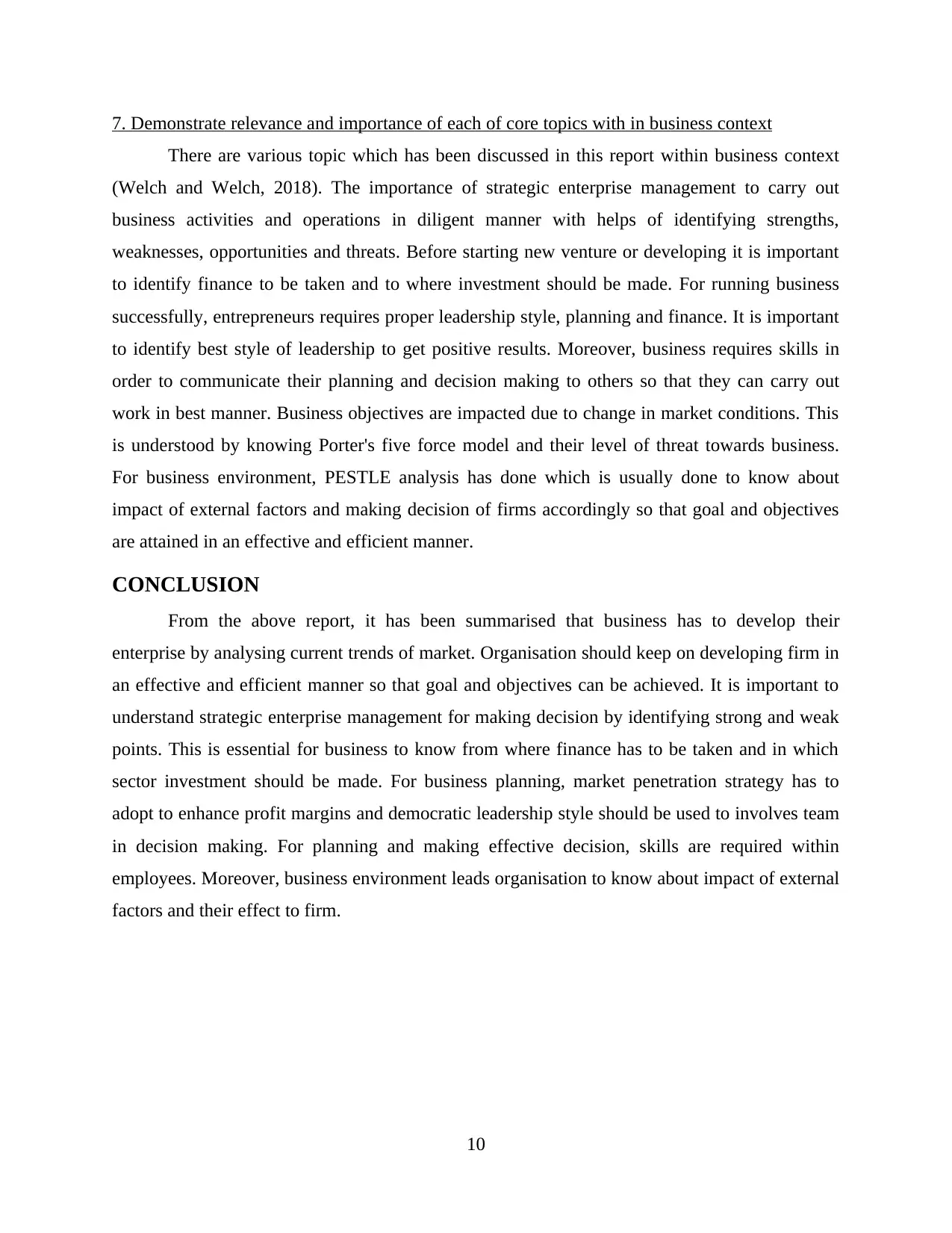
7. Demonstrate relevance and importance of each of core topics with in business context
There are various topic which has been discussed in this report within business context
(Welch and Welch, 2018). The importance of strategic enterprise management to carry out
business activities and operations in diligent manner with helps of identifying strengths,
weaknesses, opportunities and threats. Before starting new venture or developing it is important
to identify finance to be taken and to where investment should be made. For running business
successfully, entrepreneurs requires proper leadership style, planning and finance. It is important
to identify best style of leadership to get positive results. Moreover, business requires skills in
order to communicate their planning and decision making to others so that they can carry out
work in best manner. Business objectives are impacted due to change in market conditions. This
is understood by knowing Porter's five force model and their level of threat towards business.
For business environment, PESTLE analysis has done which is usually done to know about
impact of external factors and making decision of firms accordingly so that goal and objectives
are attained in an effective and efficient manner.
CONCLUSION
From the above report, it has been summarised that business has to develop their
enterprise by analysing current trends of market. Organisation should keep on developing firm in
an effective and efficient manner so that goal and objectives can be achieved. It is important to
understand strategic enterprise management for making decision by identifying strong and weak
points. This is essential for business to know from where finance has to be taken and in which
sector investment should be made. For business planning, market penetration strategy has to
adopt to enhance profit margins and democratic leadership style should be used to involves team
in decision making. For planning and making effective decision, skills are required within
employees. Moreover, business environment leads organisation to know about impact of external
factors and their effect to firm.
10
There are various topic which has been discussed in this report within business context
(Welch and Welch, 2018). The importance of strategic enterprise management to carry out
business activities and operations in diligent manner with helps of identifying strengths,
weaknesses, opportunities and threats. Before starting new venture or developing it is important
to identify finance to be taken and to where investment should be made. For running business
successfully, entrepreneurs requires proper leadership style, planning and finance. It is important
to identify best style of leadership to get positive results. Moreover, business requires skills in
order to communicate their planning and decision making to others so that they can carry out
work in best manner. Business objectives are impacted due to change in market conditions. This
is understood by knowing Porter's five force model and their level of threat towards business.
For business environment, PESTLE analysis has done which is usually done to know about
impact of external factors and making decision of firms accordingly so that goal and objectives
are attained in an effective and efficient manner.
CONCLUSION
From the above report, it has been summarised that business has to develop their
enterprise by analysing current trends of market. Organisation should keep on developing firm in
an effective and efficient manner so that goal and objectives can be achieved. It is important to
understand strategic enterprise management for making decision by identifying strong and weak
points. This is essential for business to know from where finance has to be taken and in which
sector investment should be made. For business planning, market penetration strategy has to
adopt to enhance profit margins and democratic leadership style should be used to involves team
in decision making. For planning and making effective decision, skills are required within
employees. Moreover, business environment leads organisation to know about impact of external
factors and their effect to firm.
10
Paraphrase This Document
Need a fresh take? Get an instant paraphrase of this document with our AI Paraphraser
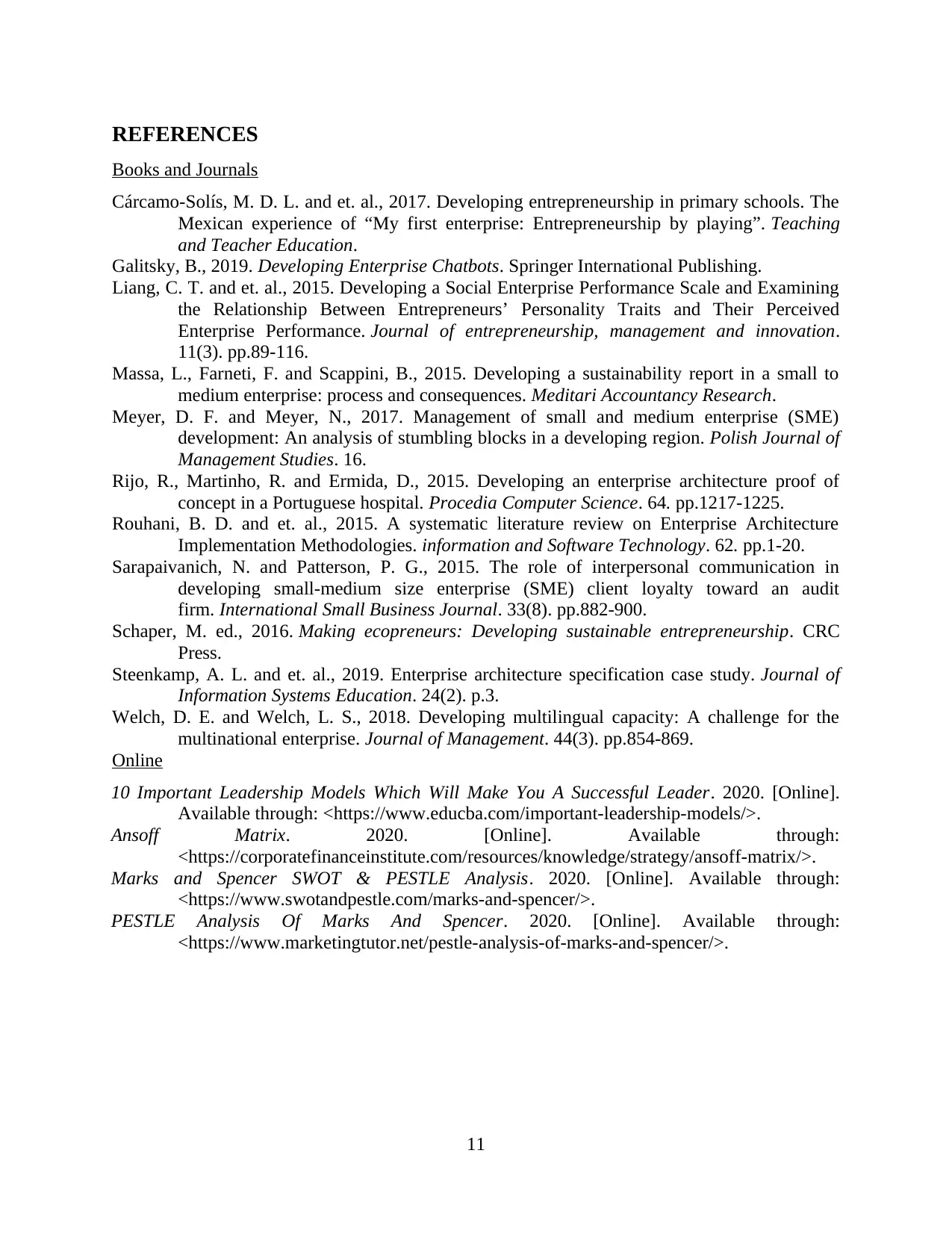
REFERENCES
Books and Journals
Cárcamo-Solís, M. D. L. and et. al., 2017. Developing entrepreneurship in primary schools. The
Mexican experience of “My first enterprise: Entrepreneurship by playing”. Teaching
and Teacher Education.
Galitsky, B., 2019. Developing Enterprise Chatbots. Springer International Publishing.
Liang, C. T. and et. al., 2015. Developing a Social Enterprise Performance Scale and Examining
the Relationship Between Entrepreneurs’ Personality Traits and Their Perceived
Enterprise Performance. Journal of entrepreneurship, management and innovation.
11(3). pp.89-116.
Massa, L., Farneti, F. and Scappini, B., 2015. Developing a sustainability report in a small to
medium enterprise: process and consequences. Meditari Accountancy Research.
Meyer, D. F. and Meyer, N., 2017. Management of small and medium enterprise (SME)
development: An analysis of stumbling blocks in a developing region. Polish Journal of
Management Studies. 16.
Rijo, R., Martinho, R. and Ermida, D., 2015. Developing an enterprise architecture proof of
concept in a Portuguese hospital. Procedia Computer Science. 64. pp.1217-1225.
Rouhani, B. D. and et. al., 2015. A systematic literature review on Enterprise Architecture
Implementation Methodologies. information and Software Technology. 62. pp.1-20.
Sarapaivanich, N. and Patterson, P. G., 2015. The role of interpersonal communication in
developing small-medium size enterprise (SME) client loyalty toward an audit
firm. International Small Business Journal. 33(8). pp.882-900.
Schaper, M. ed., 2016. Making ecopreneurs: Developing sustainable entrepreneurship. CRC
Press.
Steenkamp, A. L. and et. al., 2019. Enterprise architecture specification case study. Journal of
Information Systems Education. 24(2). p.3.
Welch, D. E. and Welch, L. S., 2018. Developing multilingual capacity: A challenge for the
multinational enterprise. Journal of Management. 44(3). pp.854-869.
Online
10 Important Leadership Models Which Will Make You A Successful Leader. 2020. [Online].
Available through: <https://www.educba.com/important-leadership-models/>.
Ansoff Matrix. 2020. [Online]. Available through:
<https://corporatefinanceinstitute.com/resources/knowledge/strategy/ansoff-matrix/>.
Marks and Spencer SWOT & PESTLE Analysis. 2020. [Online]. Available through:
<https://www.swotandpestle.com/marks-and-spencer/>.
PESTLE Analysis Of Marks And Spencer. 2020. [Online]. Available through:
<https://www.marketingtutor.net/pestle-analysis-of-marks-and-spencer/>.
11
Books and Journals
Cárcamo-Solís, M. D. L. and et. al., 2017. Developing entrepreneurship in primary schools. The
Mexican experience of “My first enterprise: Entrepreneurship by playing”. Teaching
and Teacher Education.
Galitsky, B., 2019. Developing Enterprise Chatbots. Springer International Publishing.
Liang, C. T. and et. al., 2015. Developing a Social Enterprise Performance Scale and Examining
the Relationship Between Entrepreneurs’ Personality Traits and Their Perceived
Enterprise Performance. Journal of entrepreneurship, management and innovation.
11(3). pp.89-116.
Massa, L., Farneti, F. and Scappini, B., 2015. Developing a sustainability report in a small to
medium enterprise: process and consequences. Meditari Accountancy Research.
Meyer, D. F. and Meyer, N., 2017. Management of small and medium enterprise (SME)
development: An analysis of stumbling blocks in a developing region. Polish Journal of
Management Studies. 16.
Rijo, R., Martinho, R. and Ermida, D., 2015. Developing an enterprise architecture proof of
concept in a Portuguese hospital. Procedia Computer Science. 64. pp.1217-1225.
Rouhani, B. D. and et. al., 2015. A systematic literature review on Enterprise Architecture
Implementation Methodologies. information and Software Technology. 62. pp.1-20.
Sarapaivanich, N. and Patterson, P. G., 2015. The role of interpersonal communication in
developing small-medium size enterprise (SME) client loyalty toward an audit
firm. International Small Business Journal. 33(8). pp.882-900.
Schaper, M. ed., 2016. Making ecopreneurs: Developing sustainable entrepreneurship. CRC
Press.
Steenkamp, A. L. and et. al., 2019. Enterprise architecture specification case study. Journal of
Information Systems Education. 24(2). p.3.
Welch, D. E. and Welch, L. S., 2018. Developing multilingual capacity: A challenge for the
multinational enterprise. Journal of Management. 44(3). pp.854-869.
Online
10 Important Leadership Models Which Will Make You A Successful Leader. 2020. [Online].
Available through: <https://www.educba.com/important-leadership-models/>.
Ansoff Matrix. 2020. [Online]. Available through:
<https://corporatefinanceinstitute.com/resources/knowledge/strategy/ansoff-matrix/>.
Marks and Spencer SWOT & PESTLE Analysis. 2020. [Online]. Available through:
<https://www.swotandpestle.com/marks-and-spencer/>.
PESTLE Analysis Of Marks And Spencer. 2020. [Online]. Available through:
<https://www.marketingtutor.net/pestle-analysis-of-marks-and-spencer/>.
11
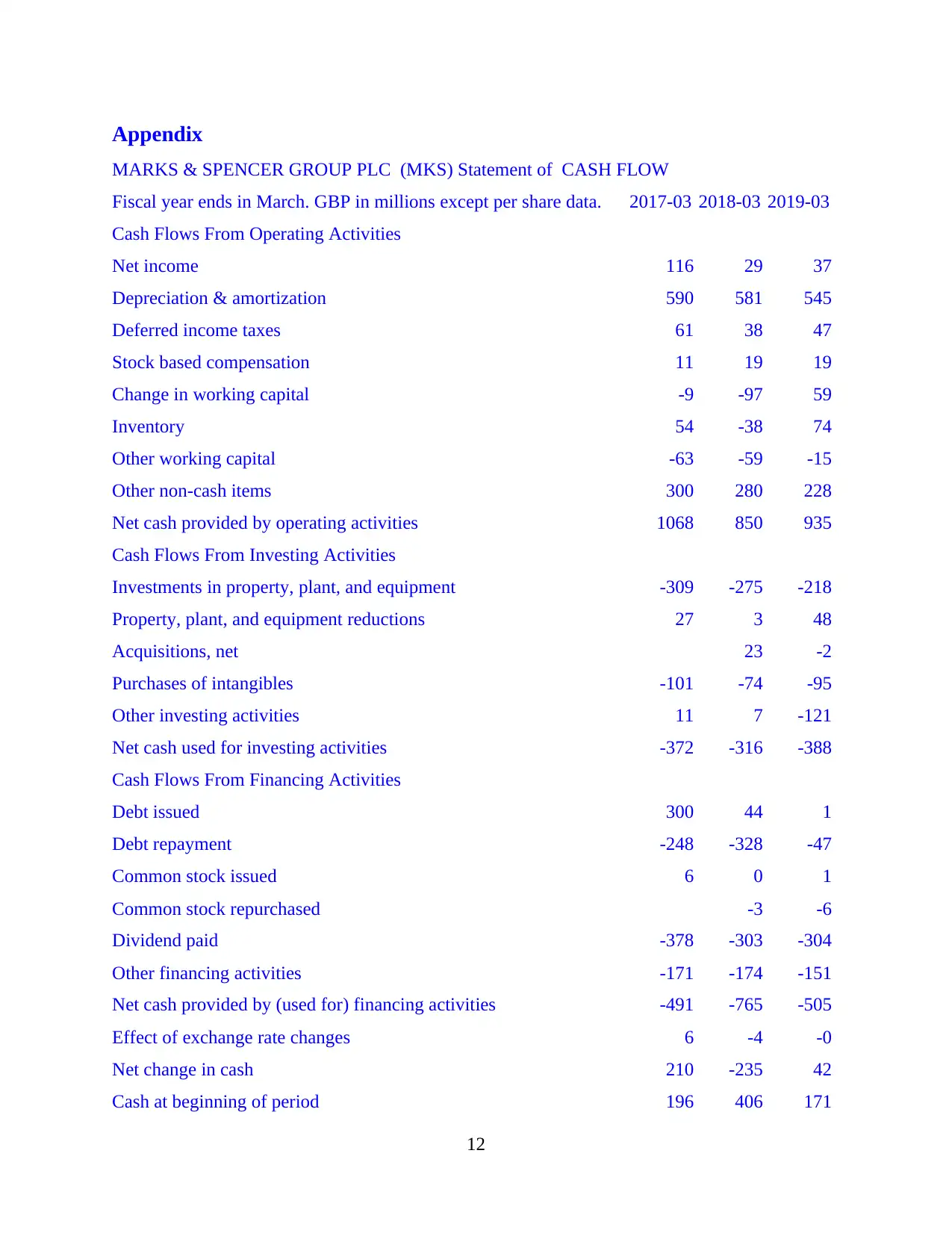
Appendix
MARKS & SPENCER GROUP PLC (MKS) Statement of CASH FLOW
Fiscal year ends in March. GBP in millions except per share data. 2017-03 2018-03 2019-03
Cash Flows From Operating Activities
Net income 116 29 37
Depreciation & amortization 590 581 545
Deferred income taxes 61 38 47
Stock based compensation 11 19 19
Change in working capital -9 -97 59
Inventory 54 -38 74
Other working capital -63 -59 -15
Other non-cash items 300 280 228
Net cash provided by operating activities 1068 850 935
Cash Flows From Investing Activities
Investments in property, plant, and equipment -309 -275 -218
Property, plant, and equipment reductions 27 3 48
Acquisitions, net 23 -2
Purchases of intangibles -101 -74 -95
Other investing activities 11 7 -121
Net cash used for investing activities -372 -316 -388
Cash Flows From Financing Activities
Debt issued 300 44 1
Debt repayment -248 -328 -47
Common stock issued 6 0 1
Common stock repurchased -3 -6
Dividend paid -378 -303 -304
Other financing activities -171 -174 -151
Net cash provided by (used for) financing activities -491 -765 -505
Effect of exchange rate changes 6 -4 -0
Net change in cash 210 -235 42
Cash at beginning of period 196 406 171
12
MARKS & SPENCER GROUP PLC (MKS) Statement of CASH FLOW
Fiscal year ends in March. GBP in millions except per share data. 2017-03 2018-03 2019-03
Cash Flows From Operating Activities
Net income 116 29 37
Depreciation & amortization 590 581 545
Deferred income taxes 61 38 47
Stock based compensation 11 19 19
Change in working capital -9 -97 59
Inventory 54 -38 74
Other working capital -63 -59 -15
Other non-cash items 300 280 228
Net cash provided by operating activities 1068 850 935
Cash Flows From Investing Activities
Investments in property, plant, and equipment -309 -275 -218
Property, plant, and equipment reductions 27 3 48
Acquisitions, net 23 -2
Purchases of intangibles -101 -74 -95
Other investing activities 11 7 -121
Net cash used for investing activities -372 -316 -388
Cash Flows From Financing Activities
Debt issued 300 44 1
Debt repayment -248 -328 -47
Common stock issued 6 0 1
Common stock repurchased -3 -6
Dividend paid -378 -303 -304
Other financing activities -171 -174 -151
Net cash provided by (used for) financing activities -491 -765 -505
Effect of exchange rate changes 6 -4 -0
Net change in cash 210 -235 42
Cash at beginning of period 196 406 171
12
⊘ This is a preview!⊘
Do you want full access?
Subscribe today to unlock all pages.

Trusted by 1+ million students worldwide
1 out of 13
Related Documents
Your All-in-One AI-Powered Toolkit for Academic Success.
+13062052269
info@desklib.com
Available 24*7 on WhatsApp / Email
![[object Object]](/_next/static/media/star-bottom.7253800d.svg)
Unlock your academic potential
Copyright © 2020–2025 A2Z Services. All Rights Reserved. Developed and managed by ZUCOL.




